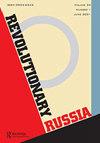The Use of History in Putin’s Russia
IF 0.2
2区 历史学
Q2 HISTORY
引用次数: 0
Abstract
scene of the 1930s – Anna Akhmatova, Boris Pasternak, Vladimir Lugovsky, Nikolai Zelinsky among many more – who were experiencing tremendous hardship due to the early years of the war, evacuation, censorship, Stalin’s terror and family dramas (much of it intimately connected). As Gromova notes, gradually one gets to see the writers’ personal stories and the many faces they encountered, or an invisible map of these people and their lives. What emerges is an entwined and distinctive landscape resembling a book of anatomy and its blood vessels (p. 80). A number of important letters and locations in central Moscow are introduced to the reader, almost taking us on a virtual tour of Arbat’s backstreets and alleyways. Whilst this is a very well written and intriguing novel, it is rather easy to get lost. Gromova focuses her book on those in the background, who surrounded the great Russian writers, not only to piece together the period but to ‘open up the past in a fuller way’. The novel’s appeal is in its archival nature, and yet, this is precisely why the reader might stumble along the way. By design, the novel continuously moves between time periods, persons and subjects – much like one would in the archives. If one does not have a notepad beside them, losing track of the characters is all too easy. Sections within lengthy chapters that regularly chop and change make for a challenging read. One line I revisited several times offers an explanation as to why the reader loses their bearings and may struggle to keep up: ‘It’s impossible to immerse oneself in an era that one hadn’t lived’ (p. 78). And perhaps that is the point; the past is gone and may be beyond our ability to reconstruct. Olga Bessarabova’s and Maria Belkina’s notebooks bring this world back to life through Gromova’s account, but in a way difficult to piece together properly. Whilst Moscow in the 1930s is certainly a slow read, it is worthwhile for scholars and students. What doors are we trying to unlock, and what keys will fit? The prize behind the door may simply be a key to another door, which when opened, takes our path in a completely new direction. Much like a mosaic, the past looks messy up close. One must take a step back to both admire and conceptualize it properly. The small pieces around the primary picture are often those which bring the past to life.历史在普京统治下的俄罗斯
20世纪30年代的场景——安娜·阿赫玛托娃(Anna Akhmatova)、鲍里斯·帕斯捷尔纳克(Boris Pasternak)、弗拉基米尔·卢戈夫斯基(Vladimir Lugovsky)、尼古拉·泽林斯基(Nikolai Zelinsky。正如格罗莫娃所指出的,人们逐渐看到了作家的个人故事和他们遇到的许多面孔,或者这些人和他们生活的无形地图。出现的是一幅交织在一起的独特景观,类似于一本解剖学及其血管的书(第80页)。向读者介绍了莫斯科市中心的一些重要信件和地点,几乎带我们虚拟游览了阿尔巴特的后街和小巷。虽然这是一部写得很好、很有趣的小说,但它很容易迷失方向。格罗莫娃的书将重点放在背景中那些围绕着伟大的俄罗斯作家的人身上,不仅是为了拼凑这一时期,而且是为了“以更全面的方式打开过去”。这部小说的吸引力在于它的档案性质,然而,这正是读者在这一过程中可能会绊倒的原因。通过设计,小说在时间段、人物和主题之间不断移动——就像档案中的一样。如果旁边没有记事本,就很容易忘记字符。长篇大论中的章节经常被删改,读起来很有挑战性。我多次重温的一句话解释了为什么读者会迷失方向,可能难以跟上:“不可能沉浸在一个没有生活过的时代”(第78页)。也许这就是重点;过去已经过去,我们可能无法重建。奥尔加·贝萨拉波娃和玛丽亚·贝尔金娜的笔记本通过格罗莫娃的叙述让这个世界复活了,但在某种程度上很难拼凑起来。虽然20世纪30年代的《莫斯科》无疑是一本慢书,但它对学者和学生来说是值得的。我们想打开什么门,什么钥匙合适?门后的奖品可能只是另一扇门的钥匙,当它打开时,会把我们的道路带向一个全新的方向。就像马赛克一样,过去近距离看起来很混乱。人们必须退一步,正确地欣赏和概念化它。主要画面周围的小片段往往是那些让过去鲜活起来的片段。
本文章由计算机程序翻译,如有差异,请以英文原文为准。
求助全文
约1分钟内获得全文
求助全文

 求助内容:
求助内容: 应助结果提醒方式:
应助结果提醒方式:


